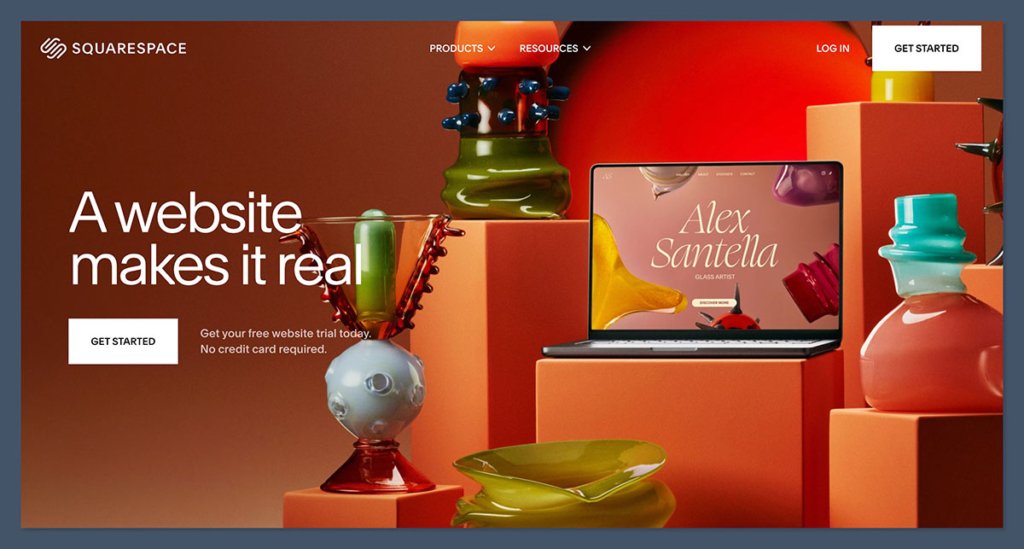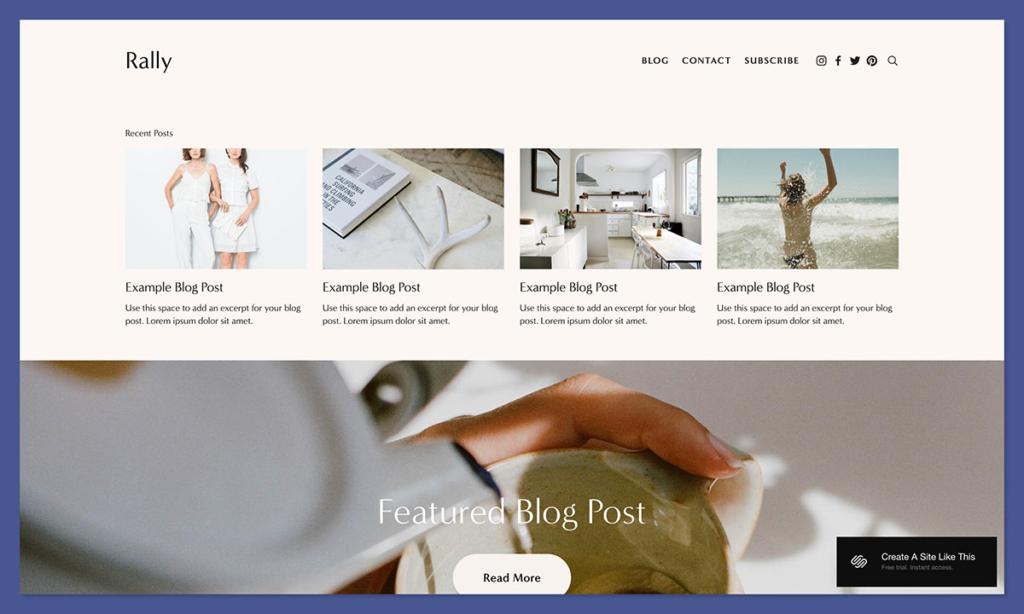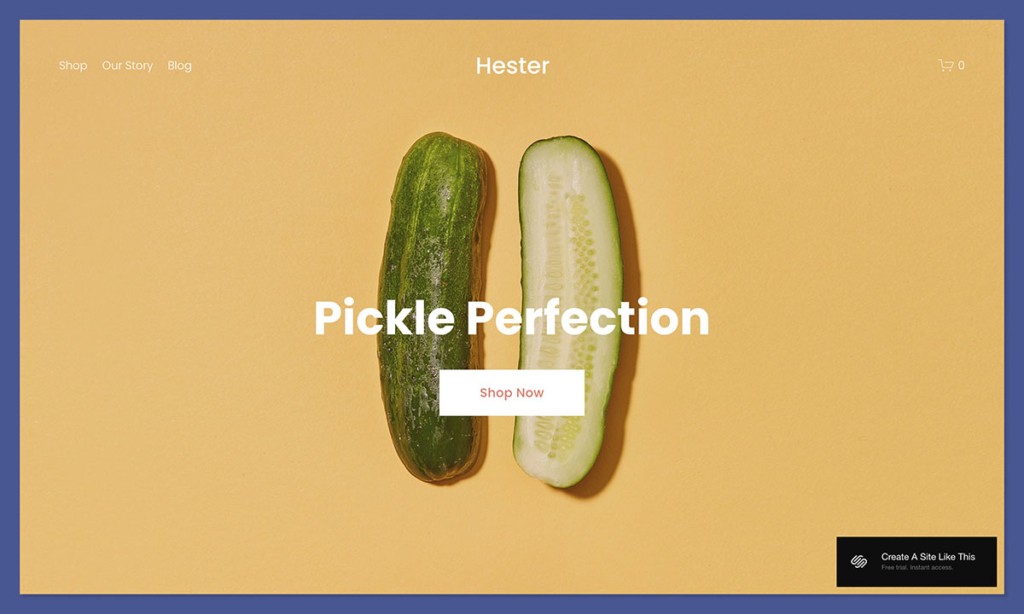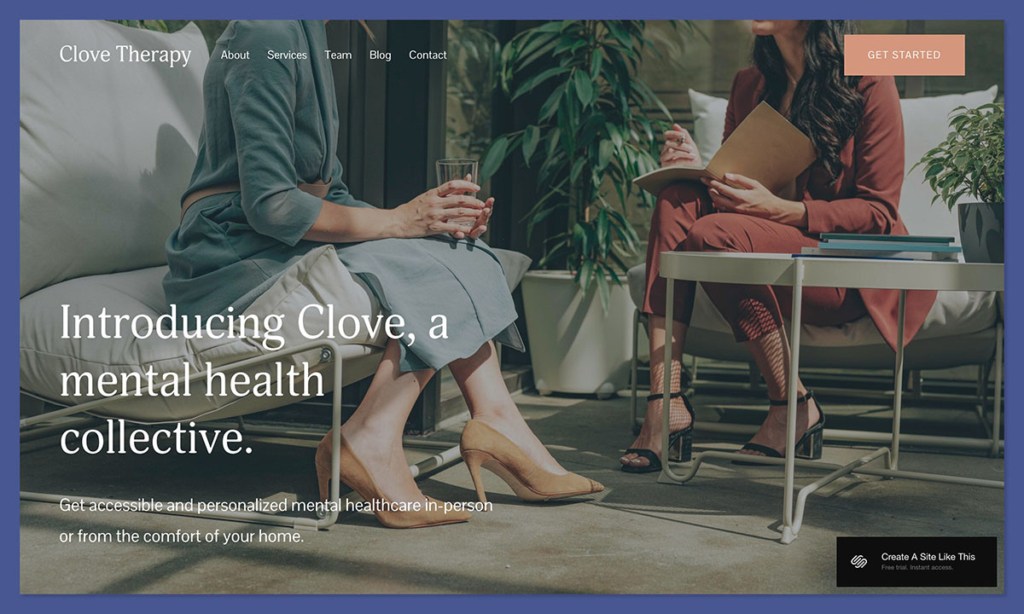
I’ve reviewed more than 6,000 ecommerce websites for ecomm.design, and worked with brands on everything from platform strategy to store design. So when people ask me how much a Squarespace website really costs, I’ve got the receipts.
Short answer? It depends.
Longer answer? It depends a lot more than most blog posts or pricing pages tell you.
Squarespace makes it easy to think it’s $12/month and you’re off to the races. But if you’re building an ecommerce business — not just a portfolio — there’s more to factor in.
Let’s break it down.
Squarespace Pricing Plans (And What You’re Actually Paying For)

Squarespace Pricing Plans (And What You’re Actually Paying For)
Squarespace keeps its pricing simple — and for the most part, transparent. These are the four main plans available when billed annually:
Personal – $16/month
- No ecommerce functionality
- Best for portfolios, personal blogs, or hobby sites
Business – $23/month
- Ecommerce features included, but with a 3% transaction fee
- Good for side hustles or testing a store idea without going all in
Commerce Basic – $27/month
- Full ecommerce support with no transaction fees
- Includes essentials like customer accounts, product reviews, and basic integrations
- Ideal for growing brands that are starting to get traction
Commerce Advanced – $49/month
- All the ecommerce features from the Basic plan, plus advanced tools
- Includes abandoned cart recovery, subscriptions, advanced discounts, and access to the Orders API
- Built for serious sellers scaling up
There’s no free plan on Squarespace. You can sign up for a 14-day free trial, but publishing your site requires upgrading to a paid plan.
If you’re searching for a forever-free option, Squarespace isn’t it — but that free trial gives you enough time to test the platform before committing.
Let me know if you want this style applied to the rest of the article.
So, What’s the Real Cost of a Squarespace Site?
The monthly fee is just the start.
If you want a site that actually performs — loads fast, looks custom, and converts — here’s what you might end up paying:
- Domain name: Free for the first year, then around £15/year after
- Google Workspace email: £5/month per inbox
- Premium template or custom code: £20–£300 (one-off or license-based)
- Third-party integrations: Pricing varies, but adds up fast if you’re using tools for pop-ups, heatmaps, CRM, or analytics
- Freelancer or agency help: £500 to £5,000+ depending on scope
So while the base cost might be $12–$35/month, the realistic all-in cost for a professional ecommerce site on Squarespace often lands somewhere between $500 and $3,000+ upfront, plus $25–$50/month ongoing.
Is Squarespace Worth It for Ecommerce?
If you care about aesthetics, it’s hard to beat Squarespace. The design quality is seriously solid out of the box.
That’s part of why I’ve featured so many Squarespace stores on ecomm.design — they just look good, especially for founders who aren’t designers.
But here’s what I’ve seen after working with ecommerce businesses for over a decade:
- Squarespace is great for first-time sellers, indie brands, and those testing product-market fit
- It’s not built to scale like Shopify or BigCommerce
- You’ll start to feel the limits on checkout, product filtering, SEO control, and app integrations as you grow
Still, if you’re in the early stages, or design matters just as much as functionality, it’s a strong platform to launch on.
Squarespace vs Shopify — The Design Trade-Off
This comes up constantly in client calls.
People say, “I love how Squarespace looks, but I’ve heard Shopify’s better for ecommerce.”
They’re right — both times.
Squarespace wins on visual polish. You’ll get a beautiful site with way less effort.
Shopify wins on ecommerce power. More payment options, more marketing tools, more control.
Here’s how I’d put it:
- Use Squarespace if you’re building a lifestyle brand, launching a side project, or want a beautiful, simple setup with low friction.
- Use Shopify if you’re aiming to scale, need custom functionality, or plan to grow beyond the basics fast.
Need proof? Only about 8% of Squarespace stores break 6 figures per year. On Shopify, it’s closer to 21%. That’s a huge gap — and most of it comes down to backend capability.
(Source: ecommerceceo.com)
Most People Miss This About the “Free Plan”
The search for a “Squarespace free plan” is huge — but the only thing they offer is a 14-day trial.
And here’s the catch:
You can’t publish your site unless you upgrade to a paid plan. So if you’re just testing layouts, that trial’s fine. But if you want to launch a live store, you’re paying.
What I Tell Clients Who Ask About Squarespace
Here’s what I usually tell ecommerce clients thinking about Squarespace:
- You’ll save time on design
- You’ll save money early on
- But you might lose flexibility as your business grows
If you’re planning to keep it small and lean — or if you want full visual control without hiring a designer — Squarespace makes sense.
But if you’re in it to grow, you’ll probably outgrow it. Most of the stores we’ve seen scale past 6-figures move off Squarespace eventually.
That’s just how it plays out.
Squarespace Pricing Overview
When you’re building a website, Squarespace has four main plans: Personal, Business, Basic Commerce, and Advanced Commerce. Each plan is for different needs: personal blog, small business website or full blown online store. Here’s a quick look:
- Personal ($16/month or $12/month): For individuals who want a simple and beautiful website without ecommerce.
- Business ($26/month or $18/month): For small businesses with e-commerce, advanced analytics and custom code.
- Basic Commerce ($30/month or $26/month): For those just starting to sell online with essential e-commerce tools no transaction fees.
- Advanced Commerce ($46/month or $40/month): For established online stores with advanced e-commerce features like abandoned cart recovery and advanced shipping options.
Squarespace Pricing ComparisonTable
| Pricing Plan | Monthly Price (Paid Monthly) | Monthly Price (Paid Annually) | Best For | Key Features |
|---|---|---|---|---|
Personal | $16/month | $12/month | Personal websites/blogs | Free custom domain (annual), SSL security, mobile optimization, basic metrics |
Business | $26/month | $18/month | Small businesses | All Personal Plan features, advanced analytics, professional email, e-commerce, custom code |
Basic Commerce | $30/month | $26/month | E-commerce startups | No transaction fees, customer accounts, point-of-sale, e-commerce analytics |
Advanced Commerce | $46/month | $40/month | Established online stores | All Basic Commerce features, abandoned cart recovery, advanced shipping, gift cards |
Breakdown of Each Pricing Plan

Personal Plan
I started with the Personal Plan. It’s $16/month if you pay monthly or $12/month if you pay annually. This plan is great if you want a simple website without all the business features.
You get a free custom domain for the first year, SSL security and unlimited bandwidth.
The templates are all mobile optimized so your site will look great on any device. But there are some limitations—no ecommerce features and only basic website metrics. But if you’re just starting out it’s a good choice.
Business Plan
As my site grew I upgraded to the Business Plan which is $26/month (monthly) or $18/month (annually). This plan includes everything in the Personal Plan plus a lot more.
You get access to premium integrations and blocks, advanced website analytics and professional email from Google.
The biggest upgrade though is the ecommerce features. You can start selling products but keep in mind there’s a 3% transaction fee.
This plan also allows you to add custom code which is great if you want to customize your site further.
Basic Commerce Plan
When I decided to get into ecommerce I found the Basic Commerce Plan to be the sweet spot.
It’s $30/month (monthly) or $26/month (annually) and eliminates the transaction fees from the Business Plan and adds customer accounts, point-of-sale options and ecommerce analytics.
This plan is great for those who are serious about selling online but don’t need the advanced features of the next tier.
Advanced Commerce Plan
If you’re running a full blown online store the Advanced Commerce Plan is probably what you need.
It’s $46/month (monthly) or $40/month (annually) and includes everything from the Basic Commerce Plan plus abandoned cart recovery, advanced shipping options and gift cards.
It’s a bit pricey but if these features will help you make more sales then it’s worth it.
Personally I find this plan most useful for businesses that have outgrown the Basic Commerce Plan and need those extra tools to maximize revenue.
Monthly vs Annual Billing
When I was choosing my plan I had to decide between monthly and annual billing. Here’s what I found: Annual billing is always the better deal if you plan to stick with Squarespace long term.
Not only do you get a lower monthly rate but Squarespace also throws in a free domain for the first year which can save you around $20.
But if you’re just testing the waters or need a site for a short term project, monthly billing gives you the flexibility to cancel at any time without being locked in for a longer term.
Additional Costs to Consider
Squarespace’s pricing is simple but there are a few extra costs to consider.
- Domain Name: While Squarespace gives you a free domain for the first year on annual plans, you’ll need to pay for it after that. Domain costs range from $20 to $70 per year depending on the extension.
- Email Services: If you want a professional email (yourname@yourdomain.com) you’ll need to use a third party service like Google Workspace which is around $6/month per user.
- Extensions and Add-Ons: Squarespace has a marketplace for extensions and while many are free some premium ones come with extra costs. These can add up depending on what you need.
How to Choose the Right Squarespace Plan
Choosing the right Squarespace plan depends on what you need from your website. Here’s my advice:
- Personal use: The Personal Plan is a good starting point. It’s cheap and has all the basic features you need to build a website.
- Small business: The Business Plan is the sweet spot. The ability to add custom code and sell products makes it worth the upgrade.
- Ecommerce Beginners: The Basic Commerce Plan is perfect if you’re just starting to sell online. No transaction fees and extra ecommerce features is great value.
- Established Ecommerce Users: If you’re serious about your online store the Advanced Commerce Plan’s features are worth the investment. It’s more expensive but those features could pay for themselves with more sales.
Is Squarespace Worth the Cost?
After using Squarespace for a bit I can say it’s good value for money especially compared to Wix and WordPress.
It’s a bit more expensive but the design and ease of use is what sets it apart.
For someone like me who values design and simplicity Squarespace’s pricing is worth it. But if you’re on a tight budget or need something very specific that Squarespace doesn’t offer then it might be worth considering other options.
How to Save on Squarespace Pricing
Here are a few tips I’ve found to save on Squarespace pricing:
- Use Discount Codes: Squarespace often has discount codes especially around holidays. A quick Google search will often turn up a code that will save you 10-20%.
- Go Annual: As I mentioned above annual billing saves you money in the long run. Plus you get that free domain for the first year which is a nice bonus.
- Try the Free Trial: Before committing to any plan try the 14 day free trial. It gives you time to try out the platform and make sure it’s right for you.
Who Should Not Use Squarespace
Squarespace is great — but it’s not for everyone.
Over the years, I’ve worked with ecommerce founders who hit a wall because they outgrew what Squarespace could do. If you fall into any of these buckets, you might want to look elsewhere:
- You need advanced product filtering (like by size, color, or custom attributes)
- You’re building a subscription-first business
- You sell high-SKU or wholesale products
- You rely heavily on custom checkout flows or upsells
- You plan to use complex third-party apps or integrations
I’ve seen this firsthand: brands that start on Squarespace eventually migrate to Shopify or WooCommerce when they start needing more control, better performance, or deeper customization.
Squarespace can get you started fast. But if your business grows fast, you’ll probably want a platform that grows with you.
Squarespace SEO: How Much Control Do You Actually Get?
SEO comes up a lot with Squarespace. Some people say it’s terrible. Others say it’s fine.
The truth is: it’s fine for basics — but that’s about it.
Here’s what you can control:
- Page titles and meta descriptions
- Image alt text
- Automatic SSL
- Clean URLs (but not fully customizable)
- Mobile-friendly templates
- Built-in sitemap.xml and robots.txt
Here’s where it starts to break down:
- No full control over technical SEO like schema, structured data, or canonical tags
- No plugin ecosystem like WordPress (e.g., no Yoast)
- Limited redirects and no full control over 404s
- No control over site speed optimization (which affects rankings)
So yeah, Squarespace will give you a clean, indexable site. But if SEO is core to your growth, and you need deeper control, it might not be enough long term.
Is Squarespace Good for Selling Digital Products?
Yes, you can sell digital products with Squarespace — but there are a few things to be aware of.
What works:
- You can sell ebooks, PDFs, music, design assets, templates
- File delivery is automatic after purchase
- You can set pricing, variants, and descriptions
But:
- There’s a 300MB file size limit
- No built-in licensing or download limits
- No digital rights management or watermarking
- No bundling with physical products (natively)
If you’re a creator selling a small number of digital goods, Squarespace is an easy way to get started. But if digital is your entire business, tools like Gumroad, Podia, or Shopify Digital Downloads give you more flexibility.
Maintenance Costs Over Time: Year 1 vs Year 3
A lot of people only think about the setup cost — but running a site on Squarespace has its own long-term costs.
Here’s a realistic breakdown:
Year 1: The Basics
- Annual Personal Plan: $192
- Domain (free with annual plan): $0
- Google Workspace email: $72
- Maybe a paid template or design help: $250
- Add-ons (optional): $100 Total: ~$600–$700
Year 3: Growth Kicks In
- Upgrade to Commerce Basic: $324/year
- Add email marketing (Pro plan): $24/month → $288/year
- Add appointment scheduling or members area: ~$200/year
- More storage or bandwidth needs = higher costs
- Maybe custom development: $500+
Total: $1,000–$1,500+/year, depending on scale and tools added
Over time, the platform becomes more expensive — not because they raise prices, but because your business needs grow.
Squarespace Templates for Ecommerce: Best Picks
If you’re using Squarespace, you’ll want to start with a template that’s built for ecommerce. Here are a few of my favorites — all of which I’ve featured on ecomm.design or recommended to clients:
1. Rally

- Minimal, clean grid layout
- Great for product-focused brands
- Easy to navigate
2. Brine (legacy but powerful)

- One of the most flexible templates Squarespace ever made
- Deep customization options without code
- Strong mobile layout
3. Hester

- Visual-first
- Designed for product storytelling
- Works great with lifestyle or fashion brands
4. Paloma

- Built for shops with fewer products
- Feels editorial
- Ideal for high-margin, low-SKU brands
5. Clove

- Clean checkout flow
- Flexible homepage blocks
- Good balance of visuals + conversion
Each of these templates works with Squarespace 7.1, and you can customize them further using the built-in style editor — no coding required.
How to Save Money with Squarespace (Legit Tips Only)
Everyone wants a deal, so here are a few real ways to cut costs on Squarespace — without hurting your site:
- Pay annually – You’ll save up to 35% vs monthly
- Start on the Personal or Business plan – Upgrade later once sales are proven
- Skip the Squarespace domain after year 1 – Transfer to Namecheap or Google Domains to save $7–$10/year
- Use one email inbox – Consolidate roles under one Google Workspace account
- Don’t rush add-ons – Only upgrade to email marketing or Members Area when you need them
- Use coupon codes – Squarespace often offers 10% off with codes like
SBR10
These small things add up — especially in the first couple years of your business.
Squarespace Pricing FAQs
Is Squarespace pricing negotiable?
No, Squarespace pricing isn’t negotiable. They have set prices for each plan and while you can save by going annual or using a discount code there isn’t any room for negotiation. But honestly I think the prices are fair.
Can I upgrade or downgrade my plan?
Yes, you can upgrade or downgrade at any time. If you upgrade the change happens immediately and you’ll be charged a prorated amount for the rest of your billing cycle. Downgrades take effect at the end of your current billing period.
What happens if I cancel my plan?
If you cancel your plan Squarespace gives you a refund within the first 14 days of purchase. After that you won’t get a refund but you can still use your site until the end of the billing period. I think this is a fair policy especially since you can cancel at any time.
Are there any hidden fees with Squarespace?
Not really. What you see is what you get with Squarespace. The only extra costs are for things like domains, email services and any premium extensions you choose to add. As long as you know about these there shouldn’t be any surprises.






